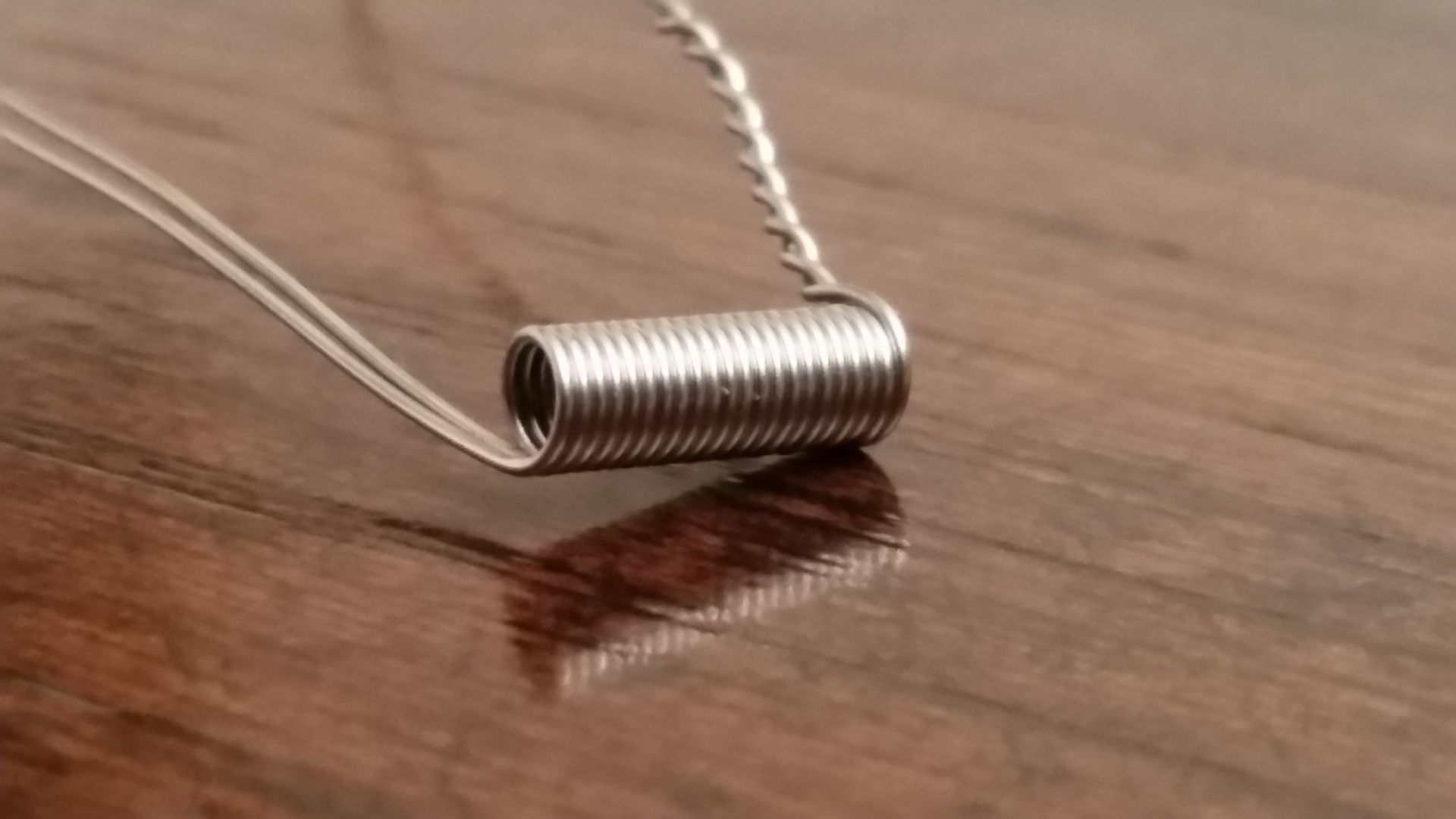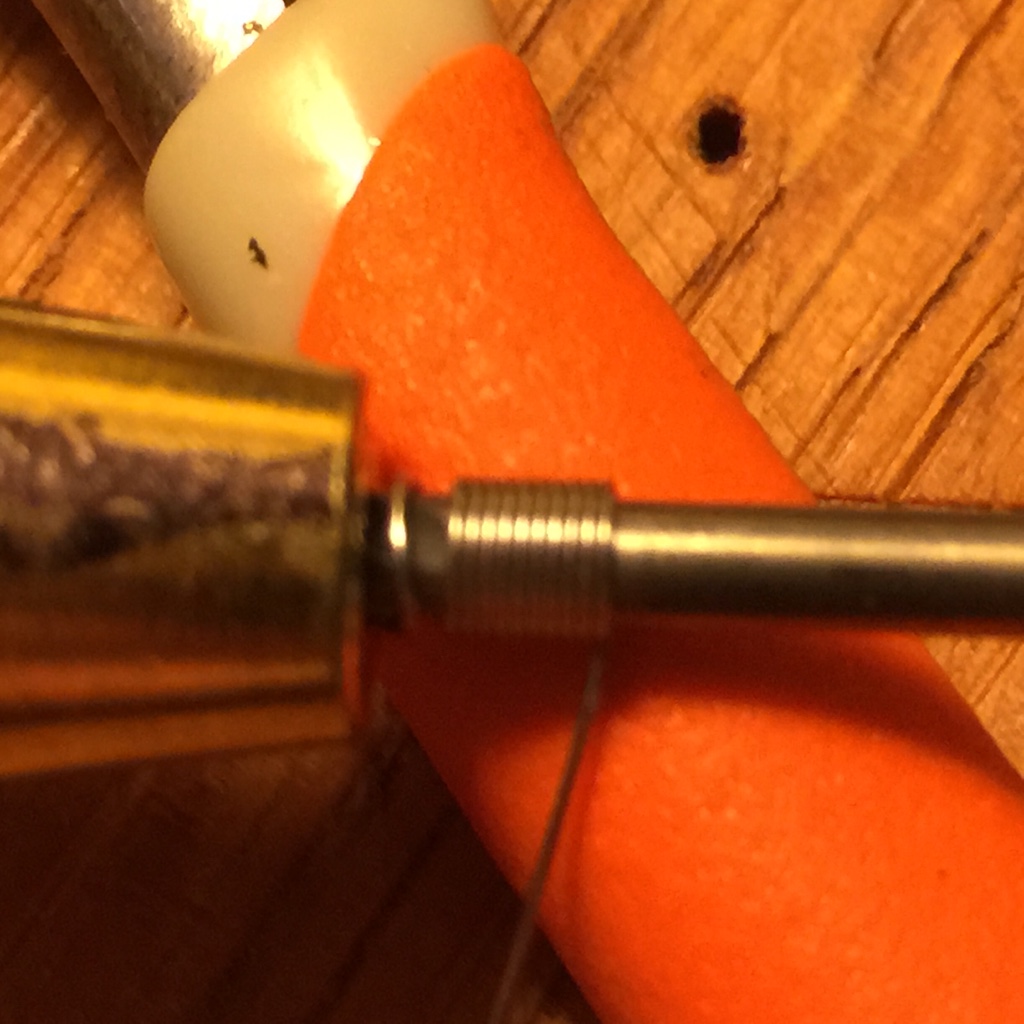Ok... finished my first
twister jig (a 1.5mm) and wrapped my first coil. All I can say is WOW!

Completely as advertised! I heeded turbocad's advise about keeping a backward angle (in relation to the rod) with the wire, and a gentle pressure into the side of the eraser and got a perfect 12 wrap coil. I only meant to wrap 10 but it was so easy I got carried away. So I peeled off 2 wraps, mounted it on a subtank mini base, and gave it a quick pulse. For the first time in my coil wrapping experience; I got a perfect, even, uniform glow across the entire width of the coil right out of the gate. Resistance reads 1.22 ohms (only .02 ohms different than Steam Engine's calculation of 1.24 ohms for a 10/9 wrap of 28 AWG). I have NEVER wound a coil
under S.E.'s calculation before. It has always been over due to the "springy-ness" of the wire and the coil expanding around the mandrel once I stopped wrapping. My normal result has been +.2ish ohms wrapping w/o tension.
I followed the oxidizing example, wicked it, vaped it, and... I LIKE IT! It does seem to vape more evenly. Each time I draw, it seems to be more uniform, from draw to draw. I can't comment as to what, if anything, it does for flavor yet as I filled the tank with unflavored. Now I need to learn how to wick it for optimal performance (somehow I can't seem to avoid those dry hits from time to time).
On a side note; my biggest concern, during the build, had to do with the pliers/clamp. After I assembled it per turbocad's directions; I was worried that there would be
too much friction on the coil as to prevent the jaws from gripping the wire as it enters the pliers. Surprisingly that was not the case. If anything, there was less friction than I anticipated. It wound so smoothly, that while I was winding, I kept squeezing harder and harder intentionally trying to "stall" my ability to rotate the jig; and I was unable to. Perhaps, as I use it more (and the leather compresses a bit more at the jaw contact points) I will be able to grab more firmly. But first impressions are extremely positive.
Disclaimer: I did deviate twice, during the assembly, from turbocad's first video. #1) I used a #1 butterfly clamp (the type that looks a lot like a pretzel with more acute corners) for added rigidity. I did this after turbocad's earlier reply. I Had first tried using a "jumbo" sized normal paper clip building along with the video. I paused the video and decided to see if I could duplicate the bends (by hand) with the small butterfly and I was indeed able to. So, for the added stiffness, I used that one in my initial build. (After using the twister; I don't believe this added stiffness is required... it really is smooth.
#2) My local Micheal's didn't have the leather so I bought a $6 pair of "full grain" work gloves from Harbor Freight (along with the pliers, drill bits, super glue,and epoxy putty. The rest I found at Staples). At first I was concerned the glove leather was not thick enough but when I got it glued into the pliers I was afraid it was too thick. Wad-do-u-know? It was just right <"ta-DA!">. I'm actually hoping the leather will compress a bit more, at the jaws, with use and give me the ability to pinch the wire a little more. Also, I did make a point to by gloves that had the "slick/almost polished outside" with a "softer/almost fuzzy inside" with the thought that the smoother outside would wear better/last longer. I'll see if this thought has any merit.
Bottom line: If this has any appeal to you; try it. I think you will be pleased.
My thanks to turbocad6 and everyone who has invested thought, time, effort, and resources finding a usable method, and more time, and effort to share their findings with me. If you ever come to Boise; I'll buy you a beer!


 Completely as advertised! I heeded turbocad's advise about keeping a backward angle (in relation to the rod) with the wire, and a gentle pressure into the side of the eraser and got a perfect 12 wrap coil. I only meant to wrap 10 but it was so easy I got carried away. So I peeled off 2 wraps, mounted it on a subtank mini base, and gave it a quick pulse. For the first time in my coil wrapping experience; I got a perfect, even, uniform glow across the entire width of the coil right out of the gate. Resistance reads 1.22 ohms (only .02 ohms different than Steam Engine's calculation of 1.24 ohms for a 10/9 wrap of 28 AWG). I have NEVER wound a coil under S.E.'s calculation before. It has always been over due to the "springy-ness" of the wire and the coil expanding around the mandrel once I stopped wrapping. My normal result has been +.2ish ohms wrapping w/o tension.
Completely as advertised! I heeded turbocad's advise about keeping a backward angle (in relation to the rod) with the wire, and a gentle pressure into the side of the eraser and got a perfect 12 wrap coil. I only meant to wrap 10 but it was so easy I got carried away. So I peeled off 2 wraps, mounted it on a subtank mini base, and gave it a quick pulse. For the first time in my coil wrapping experience; I got a perfect, even, uniform glow across the entire width of the coil right out of the gate. Resistance reads 1.22 ohms (only .02 ohms different than Steam Engine's calculation of 1.24 ohms for a 10/9 wrap of 28 AWG). I have NEVER wound a coil under S.E.'s calculation before. It has always been over due to the "springy-ness" of the wire and the coil expanding around the mandrel once I stopped wrapping. My normal result has been +.2ish ohms wrapping w/o tension.


 Took me a while to remember all the steps and for me the key one was remembering to put some pressure on the twister into the nippers, but if you don't push you get very good spaced coils (those work too in certain situations. I have been putting this off since I didn't manage to get any steel stick or the like. I have a little twister that is very much like your (Turbo's) original you did way before this. It won't let me upload for some reason so maybe I can put them up from Tapatalk later. My twister is a bit very simple. Since I got the hang of it I have also used a couple of the Gizmo wires(not in the Gizmo) and it worked great in combo with a pin vise. I have drill blanks so the pin vise was kinda exciting because of the ease of changing mandrel sizes. I usually use around 2mm and 2.5 so I am going to use the one set of nippers for those sizes and make another set up for larger wire.
Took me a while to remember all the steps and for me the key one was remembering to put some pressure on the twister into the nippers, but if you don't push you get very good spaced coils (those work too in certain situations. I have been putting this off since I didn't manage to get any steel stick or the like. I have a little twister that is very much like your (Turbo's) original you did way before this. It won't let me upload for some reason so maybe I can put them up from Tapatalk later. My twister is a bit very simple. Since I got the hang of it I have also used a couple of the Gizmo wires(not in the Gizmo) and it worked great in combo with a pin vise. I have drill blanks so the pin vise was kinda exciting because of the ease of changing mandrel sizes. I usually use around 2mm and 2.5 so I am going to use the one set of nippers for those sizes and make another set up for larger wire.  I will try to get pix up at some point. I'm just happy to get the winding down
I will try to get pix up at some point. I'm just happy to get the winding down 



